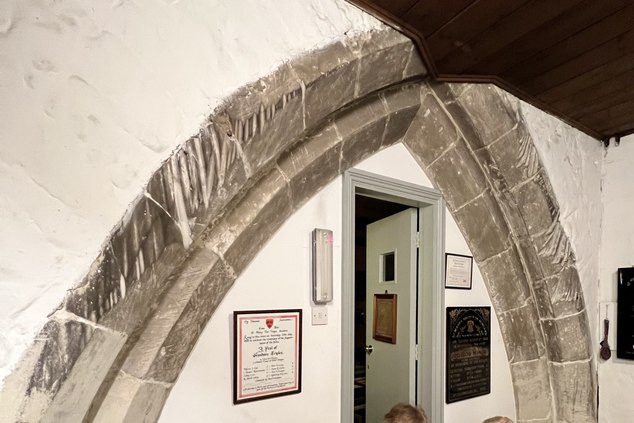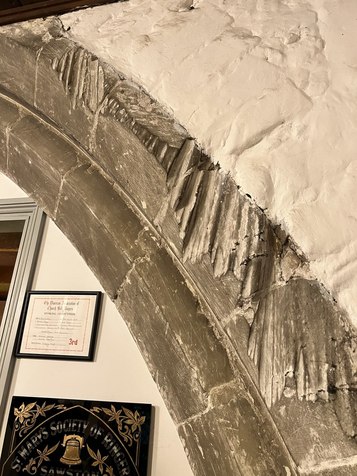-
 Richard Pargeter
25I hope this is considered an acceptable subject for the forum, although I couldn’t see a category which really fitted.
Richard Pargeter
25I hope this is considered an acceptable subject for the forum, although I couldn’t see a category which really fitted.
Can anyone suggest what our forebears used to do to carve deep grooves in the stonework of bell tower arches? The attached shows particularly deep and numerous grooves from Sawston near Cambridge, but there are plenty of other examples round here. It would seem that people used to pull bell ropes from the ground floor, inside the body of the church, so they rubbed on the masonry - but this seems a strange thing to do, and not at all good for rope life!


-
 Richard Pargeter
25But, this would have been a long way up before the ringing floor was installed, and the grooves bear a marked similarity to those which can be seen on canal bridges, caused by tow ropes.
Richard Pargeter
25But, this would have been a long way up before the ringing floor was installed, and the grooves bear a marked similarity to those which can be seen on canal bridges, caused by tow ropes. -
 John Harrison
542you sharpen a blade by rubbing it along the surface at a very shallow angle. Cutting int the stone woul blunt it.
John Harrison
542you sharpen a blade by rubbing it along the surface at a very shallow angle. Cutting int the stone woul blunt it.
My understanding is that these marks were caused when bells were chimed from a convenient place within the church that wasn't under the bell. Drawn ropes, long droughts and friction aren't the problem for chiming that they are for ringing. -
 Graham John
321It is the case though that similar marks appear lower down on church walls, which is why I said "usual explanation". I agree that sharpening a blade is done flat to a stone, and why use the church anyway rather than spare stone blocks.
Graham John
321It is the case though that similar marks appear lower down on church walls, which is why I said "usual explanation". I agree that sharpening a blade is done flat to a stone, and why use the church anyway rather than spare stone blocks.
The marks are so numerous and deep at Sawston, you do wonder how many hundreds of years of pulling and replacement ropes would be required to make them by ropes attached to bells. -
 John Harrison
542how long a groove takes to form depends on the hardness of the stone. The picture looks a bit like chalk, which isn't normally used for building because it's not very good, but we have a lot in All Saints Wokingham.
John Harrison
542how long a groove takes to form depends on the hardness of the stone. The picture looks a bit like chalk, which isn't normally used for building because it's not very good, but we have a lot in All Saints Wokingham. -
 J Martin Rushton
104Magnify the second image and you can see traces of the grooves above the voussoirs, which supports the rope theory. In passing I've seen cast iron protections on canal bridges nearly worn through by ropes,, but then they would be dirty ropes with abrasive grit and the weight on a narrowboat on the rope.
J Martin Rushton
104Magnify the second image and you can see traces of the grooves above the voussoirs, which supports the rope theory. In passing I've seen cast iron protections on canal bridges nearly worn through by ropes,, but then they would be dirty ropes with abrasive grit and the weight on a narrowboat on the rope. -
 Peter Sotheran
147I'd go with the rope-mark theory. I have seen this effect in several towers. In fact at one of our neighbouring towers, the arched doorway was relatively low by modern standards and the ropes fell within a couple of inches of the wall. The ringer of the 5th stood within the archway with the door open; consequently some of the grooves were enhanced with bloodstains from bruised & grazed knuckles!
Peter Sotheran
147I'd go with the rope-mark theory. I have seen this effect in several towers. In fact at one of our neighbouring towers, the arched doorway was relatively low by modern standards and the ropes fell within a couple of inches of the wall. The ringer of the 5th stood within the archway with the door open; consequently some of the grooves were enhanced with bloodstains from bruised & grazed knuckles! -
 Mike Shelley
50The taper of groups of worn channels gives an indication of where the ropes went through a point at which no lateral movement was occurring. That point is sometimes, (perhaps usually), a boss, but might also be, say, a pulley wheel where the rope changed direction to the clapper or hammer. A little visual geometry might come up with the height above the arch of, say, an earlier boss or pulley location. Is there a correlation between the number of groups of grooves and the number of bells known to be in the church at different times?
Mike Shelley
50The taper of groups of worn channels gives an indication of where the ropes went through a point at which no lateral movement was occurring. That point is sometimes, (perhaps usually), a boss, but might also be, say, a pulley wheel where the rope changed direction to the clapper or hammer. A little visual geometry might come up with the height above the arch of, say, an earlier boss or pulley location. Is there a correlation between the number of groups of grooves and the number of bells known to be in the church at different times?
Welcome to your Ringing Forums!
If you would like to join in the conversation, please register for an account.
You will only be able to post and/or comment once you have confirmed your email address and been approved by an Admin.
Categories
- BELL INSTALLATION & RESTORATION PROJECTS
- CALL CHANGES
- CCCBR Consultation
- EDUCATION AND TRAINING
- GENERAL
- MEMBERSHIP SOFTWARE
- MEMBERMOJO
- METHOD RINGING
- METHODS
- COMPOSITION
- CONDUCTING
- HANDBELL RINGING
- PUBLIC RELATIONS
- RECRUITMENT & RETENTION
- Ringing 2030
- RINGING SIMULATORS AND SOFTWARE
- RUNNING A TOWER
- TOWER MAINTENANCE
More Discussions
- Contact Us
- RingingForums Policy
- Terms of Service
- Useful Hints and Tips
- Sign In
- © 2025 Ringing Forums







